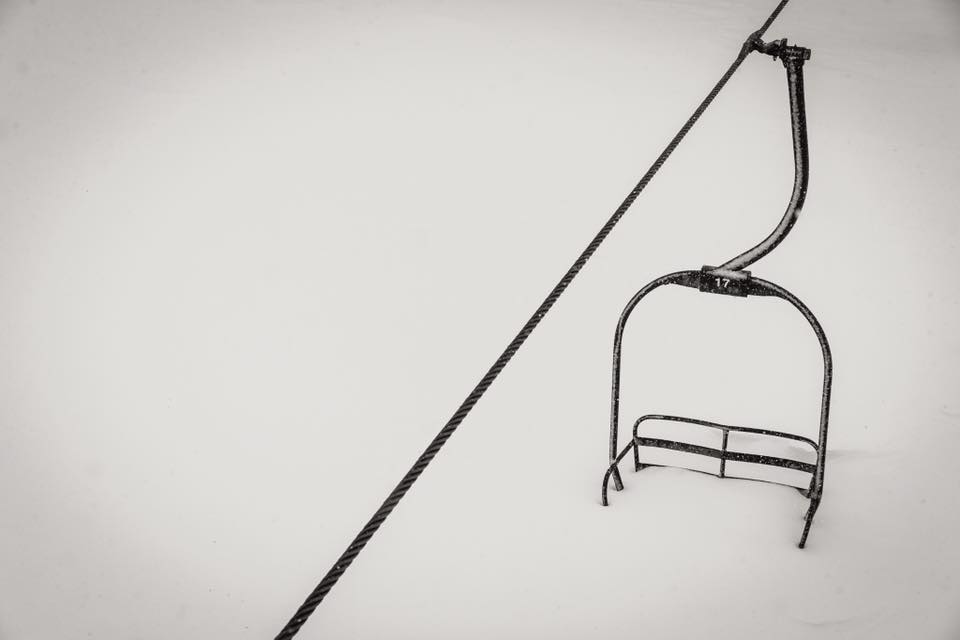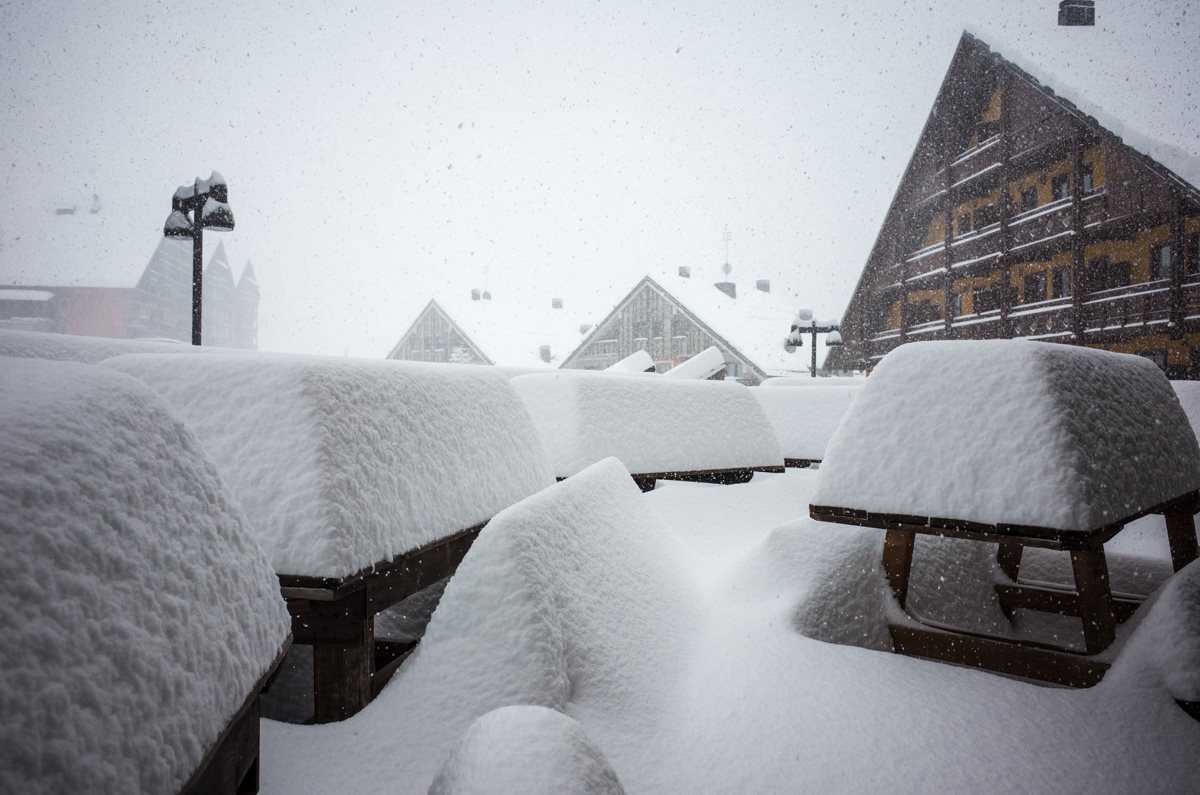People, perhaps particularly British people, tend to get over excited by snow reports. We look for forecasts of big snowfalls coming and we check our snow depths to try to get an idea of what conditions might be like.
It’s actually quite a new thing – at least the level of detail is and the fact that forecasts in particular are now updated almost by the minute.
Back in the old days you might get a weekly report in a newspaper or on Ceefax, the old TV analogue news screens. Then in the 1990s you could get more regularly updated reports by phoning an 0898 number and paying 10p a minute to hear the latest.
And now we have the internet and apps with instant live info and images. In most ways what we have now is much better, but in others all this information feeds our obsession and makes us almost feel like we can control what’s going to happen with the snow and makes us resentful if we don’t get the perfect conditions we want.
Powder everywhere!!!
Posted by Val d'Isère on Friday, 13 January 2017
In the ‘old days’ in the last century snow conditions were what they were and we just made the best of it when we arrived in resort. Although snowfall may be less reliable now than then due to climate change, there’s also now snowmaking everywhere so normally (if it’s not too warm), there’s at least some snow.
Anyway I’ve been writing snow reports for many years now and I like to think I know how they work to some extent.
There are a lot of misconceptions about what they are and what they’re not (particularly among journalists working for national newspapers it seems) , so I thought a quick guide might prove interesting to some:
1. Mountains Tend to Go Up A Lot And Have Different Conditions at Different Altitudes
Mountains are often said to be ‘snow capped’ and the size of that cap varies through the year. Hopefully, through winter, it comes down to resort level – not so hard if the resort is up near 2000m as some of the high resorts in France for example, more of a challenge if it’s a traditional village in the Austrian Tirol below 1,000m. So it is that a ski resort can have, say, snow 2 metres deep at the top of the slopes, a metre deep at mid-mountain and zero in resort – depending on where the snowline is. This kind of scenario has been the case at a lot of ski areas through the first 6-8 weeks of this season. So it is that one snow report can say “Conditions on piste are pretty good, particularly on the upper mountain” but a newspaper can scream, “No Snow in the Alps! Disaster for Skiers!”
Light and fluffy! #mammothstories
Posted by Mammoth Mountain on Thursday, 12 January 2017
2. Snow Forecasts Tend to get More Accurate the Closer to the Date that Is Being Forecast
We’ve got ever better at forecasting what MIGHT happen in the mountains if the algorythms all work out correctly. Unfortunbately despite our hi-tec weather-scenario-predicting computers, mother nature often has other ideas. Forecasts made 7-10 days ahead of a forecasted date can turn up some wild numbers. It’s quite common for some to forecast 1, 2 or even 3 metres of snow in the coming week at a resort that rarely gets more than 20 or 30cm at a time. That’s because the computer has decided such a big volume of snow could fall. Sometimes media see these big numbers and run with them, “Huge snowfall heading to the Alps” then the day comes and there’s just a few flakes. So take the big numbers under advisory and with some scepticism. They’re very much to be viewed as, “I’ll believe that when I see it.” A few days before the forecasts are much more likely to be accurate.
3. Snow Conditions Tend to be In The Eye of the Beholder
Probably the biggest areas of contention in snow reports is not actually how accurate they are but how people view them personally. The onus on freeriding over the past decade or so means that a lot of people (although in reality only a fairly small percentage of the market) want to head off piste and it is they that will complain the most if there’s been no fresh snow for several weeks. If a report says that snow depths are good and all lifts and groomed runs are open they will complain the report is too positive because it does not bemoan the fact that there’s currently no fresh powder. In reality, if the snow is pretty fresh and all the runs are open, many of us might enjoy our week on the slopes to just be blue sky days with no days of blizzards.
So if you hear someone saying conditions are really bad, or indeed really good, check the person who is saying that and what their aspirations are. Keep in mind that unlike most of the population, most people who work in ski medias and the ski industry are die hard off-piste freeriding skiers who aren’t happy unless they’ve got deep powder snow …which happens very rarely, especially in Europe.
[En direct] Après l'enneigement vient…le déneigement ! Bon courage à tous les professionnels de la station ! 😀
Posted by Val Thorens on Friday, 13 January 2017
4. The Alps Are Quite Big and aren’t the Same Everywhere
The alps, and other ski regions, are quite large really and it is quite common for the Western Alps to have much better snow than the Eastern Alps or vice versa, or for the Northern Alps to do better than the Southern Alps or vice versa. There’s no rhyme or reason to it (think chaos theory), at the start of this season, Sierra Nevada down by the Med in southern Spain had the most snowfall in Europe for a time.
The thing is that when you hear “There’s No Snow In The Alps!” and other stories its usually the case that the newspaper running the story is focusing on one small area that has got unlucky.
This Daily Mail story, for example, gives the impression the problem is for the whole Alps when resorts in the Eastern Alps had had up to 2m of snow over the 7 days before the report was written (and most of the rest of the Alps was perfectly fine really too).
5. Snow Reports Tend To Miss Out ‘Other’ Weather
We all tend to focus very much on how much snows is on the ground, how recently the last lot fell and how much is in the forecast and how soon. What we tend to miss out are whether it’s going to be blowing a gale, thick fog or even very warm or very cold. Some do report it but we tend to just look at the snow depth/snow fall numbers. It’s worth keeping in mind that wind is perhaps most likely to close lifts – and tends to get worse the higher you go, just as the snow gets deeper.
good evening!●降雪/New snow:60cm●気温/Temperature:-4℃●風/Wind :中medium ●天気/weather:雪snowclouds
Posted by Hakuba Happo-one 白馬八方尾根 on Thursday, 12 January 2017
6. Ski Resorts Don’t Usually Really Manipulate Snow Reports
It’s a bit of an old wives’ tale that ski resorts can manipulate their snow report. True there are fairly definite instances of resorts doing so, particularly in the past, and there are lots of ways in which resorts can make their reports more favourable than they are, and given that the people compiling the reports are the same people charged with getting as many people to go skiing there as possible, they obviously want the report to look as good as possible. But, these days… social media and web cams means that ludicrously optimistic reports are quickly highlighted by skiers on the slopes as highly questionable.
Tricks that can be played at some resorts in some countries (others have standard rules), include measuring snow depth at the most favourable location, ‘forgetting’ to update data when conditions get less favourable, and obviously taking live images of the best looking bit of the mountain and ignoring the bits with no snow.
7. There Is Such a Thing as too Much Snow
It’s always exciting to see reports of huge snowfalls but when lots of snow arrives at once it does tend to cause a lot of misery unfortunately – even though it can be fun to be snowed in. Access roads can be blocked, avalanche danger high and ski areas can struggle to open buried ski lifts and make ski runs safe to open. Regular moderate snowfalls tend to be better for everyone.
Tempête de neige à la station ❄️❄️❄️
Posted by Les Contamines-Montjoie on Friday, 13 January 2017
8. Snow Depth Matters, But Only To A Certain Extent
Big snow depth numbers are good news for a long season but after the snow is a metre or so deep (less on many modern slopes that have been cleared of all rocks and debris and are smooth beneath the snow) it doesn’t really matter if the snow is 50cm or 500cm deep, you’re still skiing on top of it.
9. Even Google Get It Wrong
Finally if you’re really interested in snow conditions keep in mind that there are few 100% accurate and 100% reliable sources. A few years ago Google started posting data at the top of their results so that if you asked for a snow report for a particular resort they would publish stats before you needed to go on to visit the resort’ own site or an independent ski site. Unfortunately if you did go on to check the stats on the ski resort’s own site you sometimes found there had been a snowfall Google hadn’t noticed. The thing is to keep in your mind what it is YOU want to find out from the resort you’re looking at and look at multiple information sources if you can, as well as feedback from people who are in resort, to see if it looks like conditions are what you’re hoping they are.
10.Be Realistic
Taking all of the above in to account, the best advice is to be realistic and trust your gut when you’re reading the reports and looking at online posts of wonderful snowy conditions, and then just enjoy whatever mother Nature throws at us. The weather is ever changing and remains unpredictable despite our best efforts to second guess it, and that’s actually a wonderful thing. Ski resorts are great places to be whatever the weather, so just enjoy being there.









